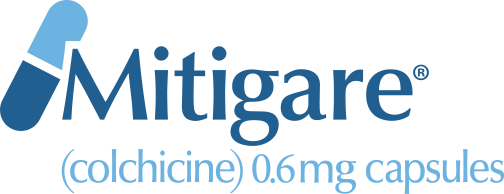
Like gout, pseudogout (pronounced SOO-doe-gout) is a type of arthritis that can cause sudden attacks of pain and swelling in one or more of the joints.1 Unlike gout, however, which most commonly affects the main joint in the big toe2, pseudogout is most likely to strike in the knee1. In what other ways are gout and pseudogout the same? How are they different? Read on to find out.
What is pseudogout?
Pseudogout, also known as calcium pyrophosphate dehydrate (CPPD) disease, is a form of arthritis.3 Similar to gout, it can cause acute attacks of pain, redness and swelling in one or more joints. Because the two diseases are so similar, a patient typically must undergo a test called synovial fluid analysis to prove one diagnosis or the other.3 (Synovial fluid is a thick, straw-colored liquid found in small amounts in the spaces between the joints.4 Synovial fluid analysis is a test during which a needle is inserted through the skin into the joint space.4 Synovial fluid is drawn into a syringe through the needle and then examined under a microscope.4) Pseudogout appears to affect about one per thousand people and is much more common in those 65 years of age and over.3
What causes pseudogout?
The cause of pseudogout is not as well understood as that of gout.3 What researchers have learned, however, is that the condition is linked to the presence of CPPD crystals in the affected joint.1,3 They also found that the number of these crystals increases with age (they are present in almost half of all people 85 years of age and over).1 However, most people who have CPPD crystal deposits do not develop pseudogout.1 (No one knows exactly why some people suffer with symptoms and others do not.1)
What are the risk factors for pseudogout?
A number of factors can increase your risk for pseudogout, including1,3:
- Age—The likelihood that you will develop pseudogout goes up as you get older.
- Trauma—Trauma to a joint, either as a result of injury or surgery, increases your risk of developing pseudogout in that joint.
- Family history—For some people, pseudogout runs in the family. These people tend to develop pseudogout at an earlier age than those who do not have a family history of pseudogout.
- Mineral imbalance—People who have excess calcium or iron or too little magnesium in their bloodstreams typically face a higher risk of developing pseudogout.
- Thyroid conditions—People who have hypothyroidism (underactive thyroid gland) or hyperparathyroidism (overactive parathyroid gland) are more likely to develop pseudogout.
How is pseudogout treated?
Unlike gout, there is no treatment currently available for pseudogout.3 The goals of pseudogout management are to ease pain and inflammation and prevent subsequent attacks (which can cause more intense pain and ultimately, joint damage).5 These goals may be achieved with over-the-counter or prescription pain relievers, and in some cases, joint drainage.1
How will I know if I have gout or pseudogout?
If you suspect you have gout or pseudogout, your doctor will examine you and order the tests needed to confirm your diagnosis.1 If the results indicate gout, it can, in most cases, be treated with urate-lowering therapy (ULT).6 To prevent flares, your doctor may prescribe a colchicine product such as Mitigare® (Colchicine) 0.6 mg Capsules (also available in generic form as Generic Colchicine 0.6 mg Capsules) in addition to ULT.7,8 If the results show that you have pseudogout, your doctor will recommend a different course of therapy that focuses on pain management and joint preservation.5
When should I see my doctor?
The sooner you find out what’s causing your pain, the sooner you can begin to do something about it. If you’ve been experiencing sudden, unexplained episodes of pain, redness and swelling in one or more of your joints, contact your doctor and make an appointment today.
Mitigare® is a registered trademark of Hikma Pharmaceuticals USA Inc.
Colchicine 0.6 mg capsules are contraindicated in patients with renal or hepatic impairment who are currently prescribed drugs that inhibit both P-gp and CYP3A4. Combining these dual inhibitors with colchicine in patients with renal or hepatic impairment has resulted in life-threatening or fatal colchicine toxicity. Patients with both renal and hepatic impairment should not be given Mitigare®.
Fatal overdoses have been reported with colchicine in adults and children. Keep Mitigare® out of the reach of children.
Blood dyscrasias such as myelosuppression, leukopenia, granulocytopenia, thrombocytopenia and aplastic anemia have been reported with colchicine used in therapeutic doses.
Monitor for toxicity and, if present, consider temporary interruption or discontinuation of colchicine.
Drug interaction with dual P-gp and CYP3A4 inhibitors: Co-administration of colchicine with dual P-gp and CYP3A4 inhibitors has resulted in life-threatening interactions and death.
Neuromuscular toxicity and rhabdomyolysis may occur with chronic treatment with colchicine in therapeutic doses, especially in combination with other drugs known to cause this effect. Patients with impaired renal function and elderly patients (including those with normal renal and hepatic function) are at increased risk. Consider temporary interruption or discontinuation of Mitigare®.
The most commonly reported adverse reactions with colchicine are gastrointestinal symptoms, including diarrhea, nausea, vomiting and abdominal pain.
Please see the full Prescribing Information and Medication Guide for Mitigare® for complete product details.
NOTE: This article was not written by a medical professional and is not intended to substitute for the guidance of a physician. These are not Hikma’s recommendations for gout flare prevention, but rather facts and data collected from various reliable medical sources. For a full list of resources and their attributing links, see below.
